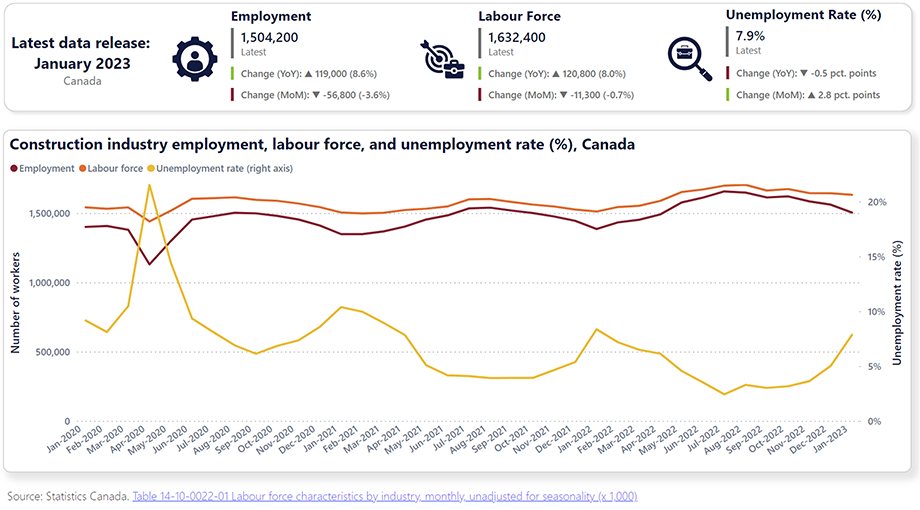Canada’s employment market continues to defy expectations.
January is typically the month in which employment reaches its lowest level, given the seasonal nature of many industries, construction included.
The latest findings from Statistics Canada’s January 2023 Labour Force Survey, however, suggest a further tightening of an already-constrained national labour market.
The all-industry national economy added 150,000 jobs in January, mostly in full-time work. This increase continued an upward trend in total employment that began in September 2022. The economy has added more than 326,000 jobs over that period – a gain of 1.7%. The national employment rate, which measures the percentage of people aged 15 and over who are employed, rose to 62.5%. Employment rates were particularly high (70.1%) among people aged 55 to 64.
As a result of the increase in employment, the national unemployment rate held steady at 5%, just shy of the record-low 4.9% reported in June and July 2022.
Statistics Canada collected data for its January survey during the week of January 15 to 21.
Key year-over-year construction indicators are elevated in most provinces
Construction also experienced employment gains – at a time of year when outdoor work is at its lowest level.
Industry employment in January 2023 increased by 119,000 workers (+8.6%) over January 2022 levels. Labour force growth performed equally impressively, adding 120,800 workers to reach 1,632,400 workers – an increase of 8%. As a result, the construction unemployment rate declined from 8.4% in January 2022 to 7.8% in January 2023.

Employment increased in nearly every province in January 2023, with the largest percentage gains recorded in Newfoundland and Labrador (+40.8%), British Columbia (+19.1%), Quebec (+13.3%), and New Brunswick (+13.1%). Saskatchewan (-1,900 workers; -4.4%) and Prince Edward Island (-500 workers; -7.6%) were the only two provinces to report losses. All of the other provinces reported gains of less than 10%.
Labour force growth trends mirrored employment trends. While Saskatchewan (-10.3%) and Prince Edward Island (-1.4%) both saw contractions in their respective labour forces, all other provinces saw growth of at least 3%. Reporting the greatest percentage increases were British Columbia (16%), New Brunswick (15.7%), and Quebec (15%). The remaining provinces again reported increases of less than 10%.
Compared with last January, unemployment rates dropped in six provinces, with Saskatchewan reporting the greatest change in its unemployment rate from a year ago. Newfoundland and Labrador and British Columbia also reported notable contractions. At 11.8% and 10.8% respectively, Quebec and New Brunswick reported the greatest percentage increases in their year-over-year industry unemployment rates.
Seasonal conditions cause month-over-month results to vary
While comparisons of metrics between January 2022 and January 2023 show a continued cycle of growth in most provinces, the month-over-month trends – i.e., from December 2022 to January 2023 – reflect the seasonal nature of industry employment to a much greater degree.
National construction employment contracted by 56,800 jobs (-3.6%) in January, while the labour force shed 11,300 jobs (-0.7%) over the same period.
Following along those same lines, all but two provinces – British Columbia ¬(+2,500 jobs; +1%) and Saskatchewan (+300 jobs; +0.7%) – saw employment contractions in January. At -32,200 jobs (-5.4%), Ontario accounted for more than half of the total national job contractions. Quebec (-15,300; -5.1%) and New Brunswick (-4,200 jobs; -14.4%) reported the next-largest monthly contractions.
Four provinces saw growth in their respective labour forces in January. Newfoundland and Labrador added 900 workers (+3.9%), Saskatchewan added 600 (+1.4%), Nova Scotia added 300 (+0.7%), and Prince Edward Island added 100 (+1.4%). Ontario’s contraction of -17,100 workers (-2.8%) was by far the largest, although not uncommon for this time of year, with New Brunswick (-2,000; -6.1%) and Manitoba (-1,400; -2.5%) also reporting large contractions.
Unemployment rates increased in every province except British Columbia, which was unchanged. At 13.7% and 10.9% respectively, Newfoundland and Labrador and Prince Edward Island reported the greatest percentage changes in their industry unemployment rates. Rates in January varied from a low of 4.3% in British Columbia to a high of 29% in Newfoundland and Labrador.


Construction Key Indicators
